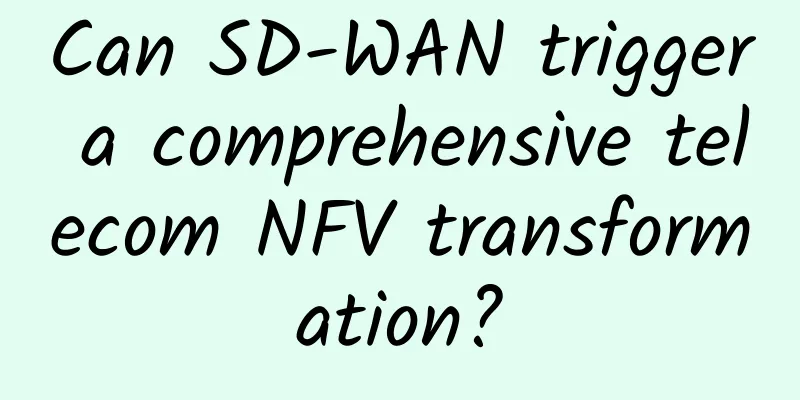Can SD-WAN trigger a comprehensive telecom NFV transformation?

|
The premise behind a software-centric, virtualized telecom infrastructure running on commodity hardware that is capable of running multi-vendor network functions and orchestrating across multiple domains remains valid. And, more importantly, it remains a laudable and important business goal. Whether this infrastructure is VM-centric or cloud-native and container-based (a more appropriate goal in the future), software-defined telecom infrastructure can still reduce operating costs, increase flexibility and agility, provide faster failure recovery, reduce complexity, and save hardware.
Carrier SD-WAN: Round One In the early days of telecom NFV, some popular use cases emerged, including virtual IP Multimedia Subsystem (IMS), virtual Evolved Packet Core (EPC), and virtual Customer Premises Equipment (CPE). While vIMS and vEPC have been launched and will continue to be launched as part of the foundation for 5G deployments, the vCPE use case has changed. When NFV was in its infancy, operators tried to figure out the right vCPE architecture: How many network functions and how many network functions should run in remote CPE, and how many should run in a point of presence (POP), central office (CO), or cloud data center? At the same time, the resurgence of the enterprise edge promoted SD-WAN as the preeminent enterprise use case. Soon, Tier 1 operators were scrambling to launch SD-WAN services for enterprise customers. Carrier SD-WAN: Round Two After their initial success with SD-WAN, telcos realized they couldn’t be held hostage by a single vendor. With Cisco acquiring Viptela, VMware acquiring VeloCloud, and Nokia owning Nuage Networks, telcos needed to leverage these major network operators. SD-WAN was increasingly becoming an enterprise edge platform where value-added services could be deployed, and telcos wanted to ensure they had control of that platform. As a result, we embarked on a Gen 2 SD-WAN architecture that included a telco-selected, telco-controlled universal CPE (uCPE) running an operating system (vCPE OS), and a choice of one or more SD-WAN VNFs. The goal of these second-generation SD-WAN deployments is to reduce the influence of incumbent SD-WAN vendors by enabling them to swap out one SD-WAN vendor for another when needed. Whether this move will actually succeed remains to be seen. After all, the reality is that SD-WANs are not mature enough and consistent enough to allow one vendor to be seamlessly swapped out for another without administrator retraining, policy and configuration remapping, automation reprogramming, and significant system reconfiguration. Even in managed SD-WAN deployments with limited enterprise access or visibility into direct hands-on SD-WAN configurations, telco managed services teams must still perform a significant amount of work to swap out one SD-WAN vendor for another. Regardless, telcos are building infrastructure to manage and host multiple VNFs on uCPE, as well as VNFs at POPs, COs, and cloud data centers to serve SD-WAN use cases. Telcos also offer SD-WAN along with value-added VNFs, such as next-generation firewalls (NGFWs), WAN optimizers, and virtual routers. Some of these are designed to meet enterprise compliance needs, adding previously certified compliant firewalls and other security appliances to SD-WAN deployments, while others are used as additional value-added services. All roads lead to NFV In early NFV demonstrations, we “hyped” and “bashed” rich VNFs for self-service markets. Unfortunately, many of these demonstrations never achieved production rollout or any significant market success. Ironically, SD-WAN was an arguably enterprise-led initiative, and we have now come full circle. These Gen 2 SD-WAN deployments are turning into full-blown NFV deployments, orchestrating across multiple vendor SD-WAN environments, and the integration of other VNFs like NGFWs, vRouters, etc. Even better, these deployments are also extending to orchestrate the underlay circuit as well as the overlay SD-WAN. We are now seeing cross-domain orchestration, connecting brownfield MPLS VPNs with modern SD-WANs or modern SD-WANs to express lanes for cloud IaaS, PaaS, and SaaS for improved performance and quality of service. Furthermore, as we have discussed in the past, with the advent of 5G FWA, these SD-WAN-driven NFV infrastructures can also be extended to cross-orchestrate 5G FWA domains. In many ways, the SD-WAN wave has been the catalyst for large-scale deployment of NFV: uCPE, POP, CO, cloud-based NFVI, VM-based and container-based VIM layers, cross-domain orchestration with NFV-O, VNFM and SDN controllers. Perhaps, SD-WAN is the panacea we have been looking for, solving many enterprise headaches, breathing life into operator NFV initiatives, giving MPLS a second chance at life, and building a bridge to the 5G future through FWA. |
<<: 5G communication requires tens of millions of base stations! How to build so many?
>>: Detailed explanation of TCP/IP acceleration principle
Recommend
RhinoTech: Dedicated servers seckill + 20% off starting at $24.5, US/Japan/Korea data centers
RhinoTech sent an email yesterday about its Augus...
[Black Friday] ExtraVM: 50% off VPS with 2GB or more memory, 1Gbps unlimited traffic, data centers in Los Angeles/Dallas/Netherlands
ExtraVM's 2023 Black Friday event is mainly f...
Is your home connected to the Gigabit Internet? There are nearly 15 million Gigabit broadband users in China
[[417031]] According to Zhongguancun Online, the ...
How IPv6 works in the Internet
[[342618]] This article is reprinted from the WeC...
Sharktech: $129/month-Dual E5-2678v3/64GB/1TB NVMe/1Gbps unlimited traffic/Los Angeles data center
Sharktech's low-priced configurations in Los ...
Tingyun launches five major weapons to realize complete DEM functions first in the country
Historical data has shown that performance has a ...
HTTP working principle and case analysis
When you enter a web address or uniform resource ...
5G message is coming, please check!
What is 5G messaging? Is it an upgraded version o...
Three-minute review! A quick overview of 5G industry development trends in April 2021
Since April 2021, my country's 5G development...
GTI releases 2.3GHz spectrum industry joint statement
As 5G accelerates globalization, it will unlock u...
A Deep Dive into Data Link Layer Devices
In computer networks, there are multiple layers t...
How did Beiming Software and Huawei achieve new highs in cooperation performance?
[51CTO.com original article] In the context of th...
In the era of stock management, operators still need to provide refined services
Recently, the three major operators announced the...
RAKsmart: 5+253 IP cluster servers starting at $177 per month, with data centers in Los Angeles/San Jose/Japan/Hong Kong available
Earlier this month, we shared the popular cloud s...
The three major operators will cancel the unlimited data packages in disguise from September 1st. Netizens shouted: I am not willing to accept it
Recently, the Ministry of Industry and Informatio...









